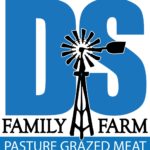Worried about what you are "really" eating? Have peace of mind with pasture grazed meats.
Pasture crop – Year One Experience
We completed year one of the CCTA-Farms Advancing Regenerative Management Systems project. The main practice we tried out was seeding annual covers into perennial grass pasture. Refer back to our September and October blog posts for more information and early results.
Bale grazed area
See below for a series of photos from an area that was bale grazed January 4, 2019. The first photo below shows a nice circle outline of where the bale was placed. The perennial grass below the bale was set back due to the left over bale residue. The seeded annuals did well.
We only clipped the annual covers (rye, vetch, winter pea) that were growing. We did not clip the growing perennial grasses. After air drying the the two samples shown in photo above:
- Grazed sample had the equivalent to 450 lbs. of growing annual cover (rye) per acre.
- Not grazed sample was equivalent to 6,700 lbs. per acre of growing annual covers (rye, vetch and pea).
Non bale grazed area
The first photo below is from September 2020. The seeded covers have emerged and growing well as the native warm season pasture grasses are going dormant.
Summer broadleaf seeding
We are seeding in old Conservation Reserve Program (CRP) lands. Native warm season grasses make up the majority of the current vegetation. Earlier this month we tried seeding warm season annual broad leaf covers. We are curious if these annual forbs will find a niche in the predominant grass pasture. From the photo, it appears the cattle herd is also curious!
Based on our early results, cattle impact prior to seeding is key. In the photo above, the pasture grasses have been “set back” by a recent graze. Stay tuned for results.













